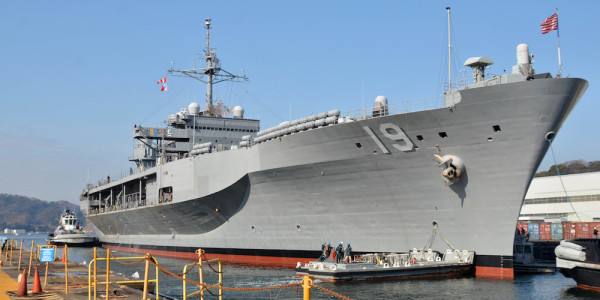

As just one of the two dedicated command ships in the Navy’s operational fleet, the USS Blue Ridge has served the United States for nearly a half-century, from the Vietnam War to the growing tensions with North Korea. But according to a new report, the 7th Fleet flagship has cultivated a secondary mission in recent years as the party yacht at the heart of the Fat Leonard scandal that’s roiled the service.
Of the 30 individuals subject to civilian charges for either receiving bribes (monetary and carnal) or lying about their connection to Singapore-based business magnate and Glenn Defense Marine Asia owner ”Fat” Leonard Francis, 15 were officers (and one an enlisted sailor) assigned to the Blue Ridge, making the vessel “perhaps the most widely compromised U.S. military headquarters of the modern era,” the Washington Post reports.
According to documents obtained through the Freedom of Information Act, Francis “doled out illicit gifts, hosted epicurean feasts and sponsored sex parties” on 45 separate occasions between 2006 and 2013 in order to ingratiate himself with Navy commanders and secure lucrative contracts for supplies and security in ports across Asia, the Washington Post reports. Among the goodies those officers consumed, per the paper: “$1 million in gourmet meals, liquor, cash, vacations, airline tickets, tailored suits, Cuban cigars, luxury watches, cases of beef, designer handbags, antique furniture and concert tickets.”
All in all, Francis managed to bilk the Navy for at least $35 million with inflated service contracts, but the report makes clear the Fat Leonard scandal is as much about operational security as it is corruption and malfeasance. A Navy spokesman told the Washington Post that Francis appears to have specifically targeted the Blue Ridge and its personnel “due to that staff’s ability to impact other ship schedules and port visit locations” — with remarkable effects. From the Post:
Staff officers on the Blue Ridge had the clout to intervene on behalf of Francis’s company, Glenn Defense Marine Asia, because they managed operations, logistics and intelligence for the entire 7th Fleet. Of paramount importance to Francis was the officers’ access to the classified itineraries of all U.S. ships and submarines transiting the region.
A master recruiter, Francis methodically assembled a network of informants to feed him the secret itineraries, court documents show. Wielding remarkable influence for a foreigner, he then prodded his moles on the Blue Ridge to reroute aircraft carriers and other vessels to ports controlled by his firm so he could more easily overcharge the Navy for fuel, other supplies and services.
It’s likely that the tally of Blue Ridge officers and sailors ensnared in the ever-expanding Fat Leonard investigation will grow in the coming weeks. While the DOJ currently has 30 subjects in its sights, the Navy’s probe into the scope and extent of Francis’ activity has expanded to at least 480 active-duty and retired personnel, including 60 admirals upon whom the businessman bestowed orgiastic dinners and expensive gifts stretching back to 1992. Among those felled by the scandal was Rear Adm. Robert Gilbeau, a former Defense Contract Management Agency commander who became the first active-duty Navy admiral convicted of a felony in modern U.S. history in June 2016, when he pled guilty to making false statements about his two-decade relationship with Francis.

Former Rear Adm. Robert GilbeauU.S. Navy
Amid all the embarrassment the Fat Leonard scandal has dropped on the Navy, none may be worse than the co-opting of the Blue Ridge, a craft the service has praised as “the most capable command ship ever built.” Designated the permanent flagship of the Yokosuka-based 7th Fleet in 1979, the vessel ran U.S. Naval Forces Central Command during Operation Desert Storm in the early ’90s. And although the vessel was built in the 1960s, the communications and computer systems remain among the most advanced in the Navy’s arsenal.
“The ships are something loosely akin to the Combined Air Operations Centers (CAOCs) that are used to integrate air wars, and the ground war below to some degree, over wide geographical areas,” explainsThe War Zone’s Tyler Rogoway with more delicious technical details. “Like CAOCs, the Blue Ridge class has been adapted to fully support coalition operations, with representatives from countries involved being deployed aboard during those operations. But the big difference is that CAOCs are based on land, not on roving ships, and they aren’t optimized for fighting in maritime and amphibious environments.”
Ironically, Rogoway notes that few photos of the interior of the Blue Ridge and her sister ship the USS Mount Whitney exist for public consumption, likely for operational security reasons: After all, the vessels are “a giant floating warfighting brains” of sorts, as he put it.
In the case of the Fat Leonard scandal, opsec didn’t seem to matter much: federal prosecutors maintain that Blue Ridge personnel didn’t just relent to the never-ending stream of carnal delights offered up by Francis, but “routinely conspired… to undermine [Navy] regulations.” Why attempt to hack a vessel when you can send the equivalent of a Goodfellas extra on board for the cost of a dinner and hooker?
Luckily, the Blue Ridge hasn’t been open to Francis’ influence in some time: The vessel just wrapped up 19 months in drydock at Yokosuka as part of a 20-year life extension plan on Jan. 28. But while naval personnel may have managed to get the stains out of the Blue Ridge’s decks, it will take some time to remove them from the command ship’s reputation.
WATCH NEXT: